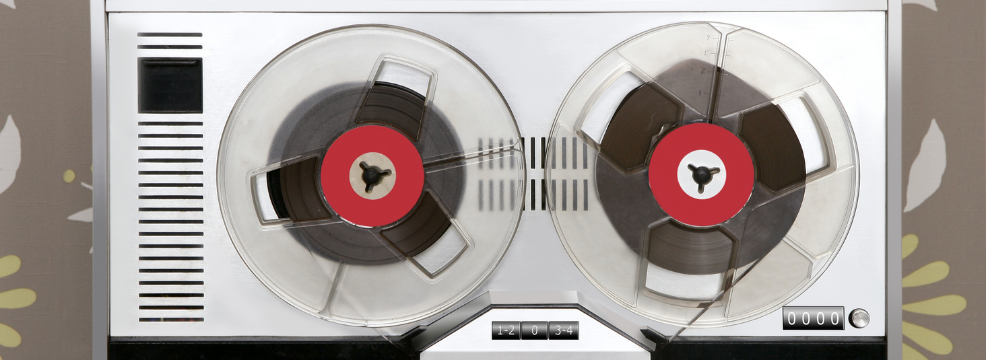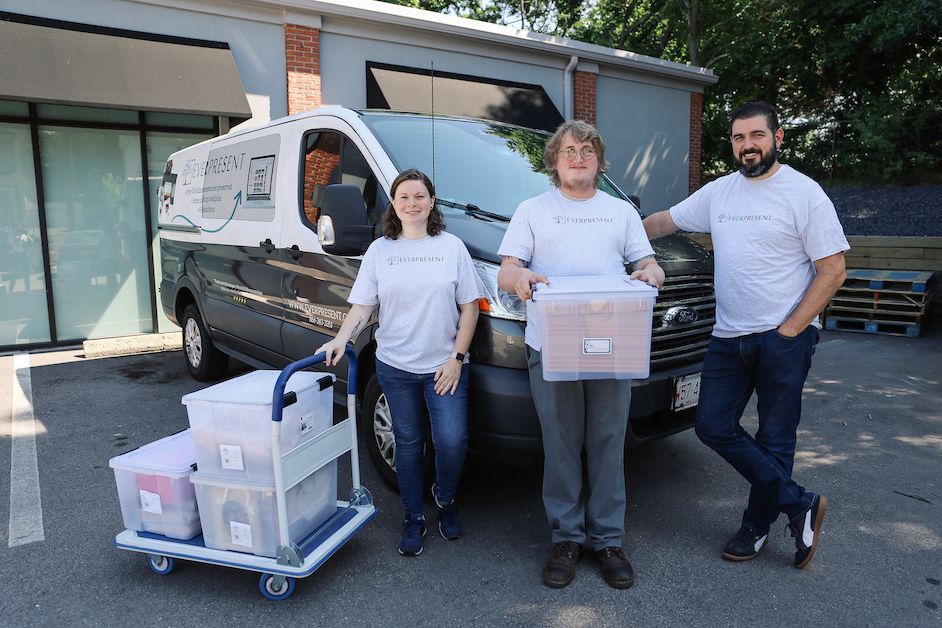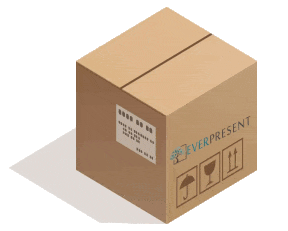TRANSFER REEL-TO-REEL TO DIGITAL NEAR YOU
WE CONVERT REEL-TO-REEL TO DIGITAL

ERIC, JENNIFER, & WINSTON
“Our ultimate goal is to make your best memories EverPresent in your life. Digitizing degrading photos and home movies is a necessary first step. Once your memories are safely digital, a world of searchable family archives and storytelling keepsakes is suddenly possible! We look forward to helping you convert your reel-to-reel to digital.”
DOES EVERPRESENT TRANSFER REEL-TO-REEL TO DIGITAL NEAR ME?
Absolutely! There are a range of reasons to choose EverPresent for your reel-to-reel digital conversion, and convenience is one of them! With over 50 local stores, home and office pickups, and easy shipping options, it’s easy to find a reel-to-reel to digital service near you!
Our customers also love the quality of our service because we are:
- Trustworthy: Over 50 million memories preserved, 30+ years experience, 80+ expert technicians. Alarmed, sprinklered, camera-monitored, US-based, high-tech lab. Advanced barcode tracking and email technology to keep you updated.
- Value for money: The size of our company allows us to provide more for less. Our projects are higher quality and better organized – and we offer an array of advanced options you won’t find anywhere else.
- Respectful: No upfront payments and no rushed decisions. We never ask you to do work to make our job easier, and we preserve your collection in order, as you organized it. We offer a dedicated point of contact for no charge for orders of all sizes to help you talk through the many decisions that arise.

Pricing & Options for Reel to Reel Conversion to Digital
- Our team will walk you through the technical options before we convert your reel-to-reel to digital. It’s free to get your materials to us for an estimate and there’s no upfront payment.
- We only charge for the work we do, not for a preset number of items. We don’t promote flashy discounts or expiring coupons. We offer volume discounts because it’s fair, and we apply them automatically.
- We offer the widest range of options and capabilities to ensure your project gets what it needs, but out of respect for your budget, never more than it needs. In our business, one size rarely fits all (or fits in a box).
Ultimately, what we care about is helping families do this important reel-to-reel digital conversion project ONCE – and do it right the first time.
Reel-to-Reel AudioStarting at $45.99 for 3" reelsSave 10% on 10+ reelsThis bulk discount will be applied automatically! |
|
|
Our standard reel-to-reel service provides excellent value for most of our clients. If you are interested in advanced options to get even more out of your vinyl collection, please review the “Upgrades” tab on the far right.
 |
|
Audio CassettesFirst 10 Audio Cassettes: $25.99/tape$15.99 for tapes 11+This 40% volume discount will be applied automatically! |
|

Our standard audio cassette transfer service provides excellent value for most of our clients. If you are interested in advanced digitizing or organizing options, review the “Upgrades” tab on the far right for our full suite of options.
Vinyl RecordsFirst 10 Vinyls: $25.99$15.99 for records 11+This 40% volume discount will be applied automatically! |
|

Our standard vinyl to digital service provides excellent value for most of our clients. If you are interested in advanced options to get even more out of your vinyl collection, please review the “Upgrades” tab on the far right.
WE TRANSFER REEL-TO-REEL TO DIGITAL NEAR YOU
HOME PICKUPS
Too many boxes to move on your own? Complimentary home and office pickups are offered throughout the Northeast for projects over $300.

LOCAL DROP OFFS - 60+ LOCATIONS
All readily available for convenient drop-off. See which store is closest to you. Our drivers personally transport projects to our local lab for digitizing.

FREE SHIPPING
We accept mail-in orders from across the U.S. We’ll email a pre-paid UPS label or apply a shipping credit if you ship on your own.

Everything you need to know
about your Audio Reel-to-Reel project
Absolutely! Whether you need to digitize ¼ inch, ½ inch, 1 inch, or 2 inch open reels, a professional reel-to-reel digital conversion service can help.
The process involves transferring the analog audio content stored on the tapes into digital format. This typically requires specialized (read: expensive) equipment such as a reel-to-reel tape player, analog-to-digital converter, and audio editing software. To avoid damaging your reel-to-reel tapes, we recommend finding a specialist service near you.
To convert reel-to-reel tapes to digital, we primarily use fully restored players from TEAC, Tascam, Sony or Otari. Our specialty is ¼ inch full and half-track open reels. This size of audio reel represents over 90% of what’s out there, and over 99% of what families and organizations have in their archives. Larger ½ inch, 1 inch and 2 inch open reels were almost exclusively used in studio production environments. The best equipment for areel-to-reel digital conversion is old equipment that must be constantly maintained and restored. We spend $1,000 to $3,000 initially on each machine and almost that much annually restoring each one.
Initially, the audio reel is examined, cleaned and set at appropriate tension for capture. Then, the reel is fed through the machine to an empty reel that captures the footage as it plays through the machine. The reel itself is played on the vintage equipment, but then connected via high-density audio cables to a pre-amp, and then into a very powerful computer. Depending on the nature of the reels, we are capturing in stereo or mono depending on the original recording style. Once the footage is on the computer, we check it for quality and produce final .mp3 files or CDs. If clients would like individual music tracks split and labeled based on the original reel-to-reel recordings, we can do that.
The improvements come after the transfer. Reel-to-reel footage suffers from inconsistent noise levels, crackles and other issues. The files are initially created as an uncompressed .wav file, at which point we apply software to reduce hiss, equalize volume levels and remove crackle. It’s not a full audio restoration, but it helps a lot. At that point, our audiophile clients sometimes ask for the exports to be full .wav files, which are large and good for sound editing. But most of our clients prefer .mp3 files that work on their smartphones, or CDs to play on their home stereos.
If you’re digitizing your reel-to-reel tapes, you don’t need to worry about cleaning them beforehand. Your chosen service provider should do this for you!
If you’d like to clean them to preserve them, we advise great care and caution (or even getting a professional service to do this). Start by inspecting them for debris, damage, and mold, so you know what you’re dealing with. Then, prepare a cleaning solution by mixing isopropyl alcohol with distilled water. Using a damp lint-free cloth, very gently wipe the tape surface with the solution. Leave it to air dry then repeat if needed. Remember, reel-to-reel tapes should always be stored in a cool, dry, and dust-free environment to prevent contamination and damage.
Unfortunately, yes, reel-to-reel tapes are particularly susceptible to degradation and damage. The magnetic tape can become brittle, develop cracks, or suffer from physical damage, while the magnetic oxide coating may degrade, leading to loss of audio fidelity. Some tapes are also prone to sticky shed syndrome, causing the tape to become sticky and difficult to play. Mold and fungus growth can also damage tapes stored in damp environments. If you’re concerned that your reel-to-reel tapes may be degrading, you should digitize them before the damage becomes significant, as this will preserve the audio content in a stable digital format.
In the grand scheme of digitizing businesses, reel-to-reel tapes are one of the rarest formats. Honestly, reel-to-reel tapes are a situation where if the price seems too good to be true, it probably is. Reels run slowly through the machines, are very finicky, use expensive equipment, and require some post-transfer work in most cases. If you see something really cheap, it means it’s a set it and forget it situation with the digitizing service. That can be OK for some formats, but not for audio reels. The other piece of this is knowing your own reels, which can be asking a lot. Many companies will just transfer at one speed and one track and that’s it. But audio reels can have four discrete tracks at different recording speeds. If you’re not careful, the digital rendering of the reel can be too slow, too fast, or just miss tracks altogether. So as you think about a service, if you know your reels have some complexity, you should confirm the digitizing process at the service can accommodate.
Get an estimate on your reel-to-reel conversion project!
Fill out our form or call to speak to a consultant
- Digitize Photos
- Video Transfer Services
- Slides to Digital
- Album & Scrapbook Scanning
- Film to Digital
- Audio Conversion
You’re in good hands! Our team has decades of experience turning millions of photos and videos into beautiful digital memories that you can share with others.
Reel-to-reel audio in action
In use since the early 1940’s, reel-to-reel audio tapes were the preferred recording method of professional artists through the 1980’s, even after cassettes became popular consumer products. Reel-to-reel recording is still used today as an alternative approach for recording artists. Like shooting film for photographers today, recording on reel-to-reel tape has revived a cult following. It’s said to have a more natural and warm sound that is hard to replicate in digital recordings. Reel-to-reel tape measures 1/4″ wide, or about twice as wide as the cassette tape, and varies in length. Because of the greater width of reel-to-reel tape, it is thought to be much higher in quality than any other recording format of its time.
These tapes often sound beautiful but they have been known to deteriorate over time. We recommend that you digitize reel-to-reels as soon as possible to preserve their beautiful sound quality.


